We have a food emergency among our Italian fans.
erp’s husband, the “Cranky Grouch,” has been doing well on our diet but retains a “crazing” for pasta:
He’s lost 30 lbs without trying very hard and gives in to the crazing (not a typo) for pasta, but he’s cut down drastically on bread and desserts, so he gets full credit. He’s of Italian background and can’t be expected to never again eat his beloved macaroni.
Unfortunately, rice noodles haven’t pleased him:
Paul, My husband doesn’t like rice noodles. We’ve tried several varieties and I have to admit, I don’t like them much either, but then, I’m not a pasta fanatic.
I’d rather have tomato sauce, known around here as gravy, over plain white rice — to him, it goes against the nature of all things holy.
Mamma mia! Tomato sauce over rice – we can do better than that.
Franco also misses his pasta:
Man, I miss carbonara, you can’t believe how difficult it is to not eat pasta as an italian! And nobody tell me rice noodles is a substitute!
We sympathize with these complaints because it took us a while to figure out how to make rice noodle dishes.
At first we struggled: some brands just didn’t taste good, and it was so easy to overcook the delicate noodles into a soft and mal-textured goo. But now that we know what we’re doing, we much prefer rice noodles to wheat. Now when we taste wheat noodles, they seem tough — we don’t miss them a bit.
I know it will be hard to persuade our Italian readers that rice noodles are better than wheat … but maybe we can help them enjoy their purgatory a bit better.
So, here it is: Cranky Grouch’s Spaghetti. Our best shot at winning over a skeptical Italian. (Franco, sorry, this one is Bolognese. Perhaps we’ll do a carbonara later.)
Rice Noodles
First, there are many different brands and different sizes of rice noodles. It took some searching, but we now have a favorite. It is a Thai brand:
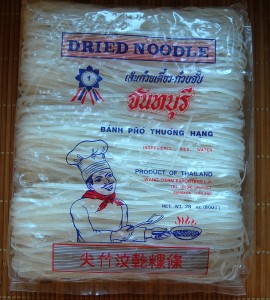
We especially like this thickness: it cooks evenly but not too quickly. We use about one-third of a bag each time in order to serve four people.
There are a few tricks to cooking rice noodles. First, they cook very rapidly – much faster than wheat. And you want them al dente, a little chewy, not soft. So you have to be fast.
Bring a pot of water to a boil. When it is actively boiling, add the rice noodles. Cover briefly, until it returns to a boil. Then immediately take the lid off and use chopsticks or some other implement to stir and separate the noodles from each other.
Taste the noodles to judge when they are done. They should be chewy, neither soft nor crunchy. Cooking time varies with the thickness of the noodles, but for these it is about seven minutes.
As soon as they reach this al dente state, immediately empty the pot through a strainer, return the noodles to the pot, and cover them with cold water momentarily to cool the noodles and stop them from cooking further. Pour them through the strainer again.
Now transfer the noodles to a container – we use a wok – and add some olive oil. Coating the noodles in oil will prevent them from sticking together. Mix the oil and noodles thoroughly.
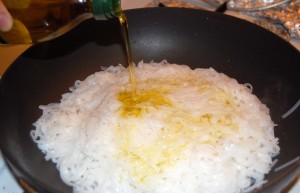
These oiled and cooked noodles are ready to eat, but can be stored in the refrigerator if you wish, and re-heated in a microwave for eating.
Bologenese Sauce
You can prepare the sauce simultaneously with the noodles. I’m sure everyone is familiar with how to make this sauce, so I’ll just share what we do.
We start by browning some ground beef. We find the natural fat from 80% ground beef provides just the right amount of oil, so we neither add extra cooking oil nor drain away the fats after cooking the beef.
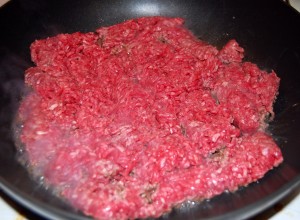
We’ll also include some sweet Italian sausage, to vary the taste a little. We’ll be slicing the sausage into bite-sized chunks but we find that can be done just as easily after the sausage has cooked a little, so to speed things along we’re throwing the whole sausages into the beef along with some onion. We like to stir-fry the onion about 2 minutes before adding the sauce.
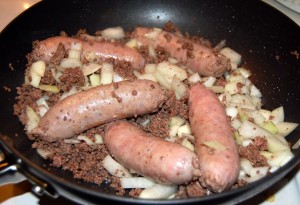
We use store-bought spaghetti sauce – in this case, a Trader Joe’s marinara sauce – which saves some time. At the same time we add the sauce, we start pulling out sausages and slicing them:
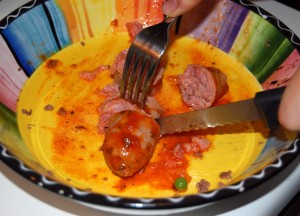
The partially cooked sausage slices are then returned to the pot to finish cooking. We also add salt and pepper at this point, and usually (but not tonight) spinach.
When the sauce ingredients are well cooked, we add some frozen pre-cooked peas.
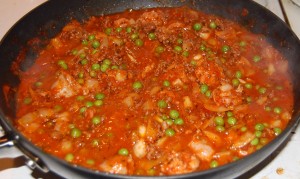
We stop cooking about 2 minutes after adding the peas.
Now just put some of the rice noodles in a bowl and ladle sauce on top. The hot sauce will warm the rice noodles.
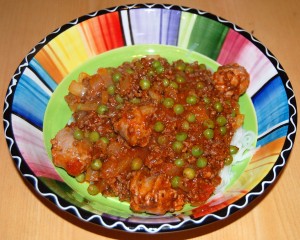
There you are! An easy spaghetti dinner that, we hope, will please even the Cranky Grouch.










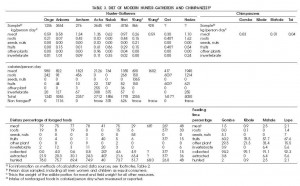
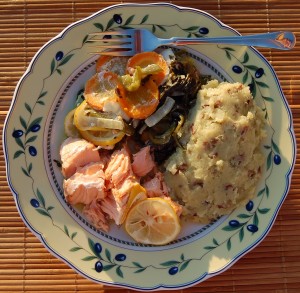




Recent Comments